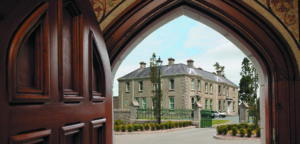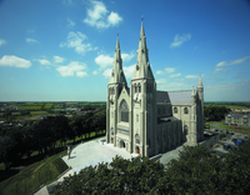CENTENARY OF THE DEDICATION OF ST. PATRICK’S CATHEDRAL, ARMAGH
HOMILY GIVEN BY
MOST REV DR SEÁN BRADY
ARCHBISHOP OF ARMAGH
SUNDAY 12 SEPTEMBER 2004
This Cathedral was dedicated and opened for worship on 24 August 1873 by Archbishop Daniel McGettigan. Although completed, the interior was then plain and uninspiring. But, over the next thirty years all of that was to change with the provision of the lovely mosaic, the ornately painted ceilings, the beautiful stained glass windows and the finely carved stone statuary. When all this had been done and paid for, as the law of the Church required at the time, the consecration could take place. The day chosen was 24 July 1904. Cardinal Logue was celebrating the Silver Jubilee of his ordination on the same day. Today, we use the chalice which Cardinal Logue used, for the first time, on that day. Give thanks to the Lord for He is good. For His love endures forever, as the Psalms tell us. So, it seemed right and good to remember all of this and to give thanks at some stage during this year. That is why we are here today. Bishop Clifford and I welcome you all and thank you for coming.
In 1904 Ireland did not have diplomatic relations with the Holy See so Pope Pius X, now St. Pius X, sent Cardinal Vanutelli to represent him at the ceremony. Today we are pleased to warmly welcome Archbishop Lazzarotto, the Apostolic Nuncio, who, of course, is the permanent ambassador of the Holy Father in Ireland. Cardinal Daly, our retired Archbishop, is always most welcome among us. I am very happy that so many bishops are able to be here this afternoon. Monsignor Dan Carr represents the Bishop of Raphoe, the native diocese of both Archbishop McGettigan and Cardinal Logue. Monsignor Carr is especially welcome.
The Cathedral in any diocese represents the aspirations of the whole diocese. That is why is it so pleasing to have the representatives – priests, religious and lay faithful – from the parishes present in such numbers. You are all most welcome.
As you approach this blessed City of Armagh, there are certain points from which you are granted your first sight of this sacred place. Perhaps it is the facade and twin spires, perhaps just both spires, or even one, depending on the direction, and the lie of the land. I am thinking particularly of the approach along the Newry Road, as you cross over through the Drumlins. Let me call those points, ‘The Places of Joy’. In a similar way, The Crusaders who converged on The City of Jerusalem, The Holy City, at the beginning of the last millennium, carefully noted the points from which they could first glimpse the buildings of The City, and they named those places ‘Mount Joys’, or ‘Mounts of Joy’. Wonderful. Because, the first sight from a distance of a sacred place, of its towers and spires and minarets, is truly the re-kindling of an intimacy and a warm affection that ultimately reaches to the origins of everything we are and can be. That is, The Holy Trinity, Father and Son and Spirit. This Cathedral of St Patrick in Armagh is truly a place made sacred.
This centre of the local church is a Place of Divine Presence. It is enriched with the perpetual presence – the real presence. This Cathedral has witnessed so many moments and preserved so many memories, both joyful and painful. And, let me say this too, it is a reminder of that other sacred place known to each of us, the family home. I don’t consider this merely a sentimental connection, it is that also and we think of the many emotional journeys from the family home to the Cathedral – for Mass and marriage, for baptism and burial, for forgiveness and friendship. But, in celebrating the meaning of this Cathedral, I feel I should also emphasise this fundamental aspect of life – family life – in our diocese. As in this House, so too in each Christian Home
Each is a house-of-prayer;
Each an arena where The Spirit of The Lord Jesus is at-play;
Each a setting in which to carry out The Twin Commandments-of-Love!
Each a place of nourishing and healing.
Each a centre for learning the following of Jesus in this 21st century,
and each is especially the dwelling place of the Holy Trinity.
But is this anything more than a handful of sound bites, just for the occasion? Let us reflect a little more on this impressive building, while keeping the family home in mind, step by step.
Just as St Patrick’s Cathedral is a Temple made of well-wrought stones and metals and timbers, so too this diocese is a Body-of-Christ knitted together with Living Stones by The working of The Holy Spirit. I am very hopeful that we shortly can begin reflection on a long term Vision for the diocese that will gather us all together even more closely, as the active Body-of-Christ in 21st century Irish society.
The great desire of God for His temple has always been that it continue to be a House of Prayer for all nations. This is still a notable challenge to become a House of Prayer for all. With God’s Help, we will continue to extend our arms, as Jesus did, in openness, to praying with all.
For me, linked with this thought – House-of-Prayer – is the fact that the Cathedral is the place of the Bishop’s chair. It is not in any way a royal throne, rather from here, the bishop’s teaching and example go out to the whole diocese. It is not a case of pious boasting, or churchy talk, it is essentially what is expressed in my own motto: ‘To Know Jesus Christ’ It is an invitation which comes to us through St. Paul to know Jesus Christ and to know him intimately.
For many years now I have come to realise, as a priest, and now as bishop, that I can hope to come close to Jesus, only if I do what He did and if I encourage others to do the same. My desire is that all parents would take up the same role, towards each other, and towards their children!
One great biblical image I associate with the Bishop’s chair in this Cathedral is The Rock. I repeat, it is not at all a royal throne the bishop is sitting on, but
The Rock.
The Rock that is the Holy Trinity.
The rock that is the Christ.
The Rock that is Peter.
The Rock that is Patrick.
This is the rock that must inspire support and nourish all of us.
As I said at the beginning, as you approach Armagh you catch your first glimpse of the twin spires. They have been newly enhanced in the recent renovations. They stretch their arms to the skies as a hint or reminder of some truth or other.
Perhaps the Old and the New Testament,
Perhaps the two traditions in Northern Ireland,
Perhaps our Lord and Our Lady.
My own interpretation takes all of those possibilities into account. “The building and dedication of this magnificent Cathedral one hundred years ago was, in itself, a statement, a statement of faith and love. The twin spires are a reminder, visible to all, of the twin commandments of love, each mirroring the other:
Love the Lord your God
Love your neighbour and yourself.
Properly understood and practised, and especially not separated one from the other, the twin commandments would definitely underpin all political initiatives for the healing of society, both civil and religious.
Yesterday the world remembered the destruction of two other spires – the Twin Towers of the World Trade Centre in Manhattan, New York. That also was a statement, a statement of hatred. It opened the eyes of many to the forces of evil at work in the world.
Today we celebrate Racial Justice Sunday. It is a day on which we are encouraged by Churches Together in Britain and Ireland to focus our worship and our thinking on the theme of Racial Justice. Today we remember that the Universe was created by a loving God, where all human beings are equally children of God and loved by God. Since none is outside the love of God, none should be outside our love either.
There is one race, the Human Race. Until that message is heard and heeded, the safer world – so earnestly and eagerly desired – is not likely to materialise. The reason is that racism persists in our midst. It sometimes takes the form of brutal physical attacks which end in murder. Racism takes other forms as well, like popular prejudice against the Travelling Community or against people seeking asylum, or reluctance to accept people of a different ethnic group as neighbours.
I believe that the diversity of the human race was not a mistake on the part of God, nor is it a threat to anyone. Many people took a message from that horrific tragedy of the Twin Towers in Manhattan. They saw it as a reminder to take religion more seriously and no longer marginalise it, either in our own lives or in the lives of others.
The Twin Spires of Armagh remind us of the Twin Commandments of love. Only the Twin Commandments of love can ensure that never again will there be a repeat of atrocities like that of the Twin Towers of the World Trade Centre, New York”.
Before he died in 1887, Archbishop McGettigan had the impressive seven terrace flight of steps constructed leading from the gate to the main door. I am sure they represent, for most of us, the effort involved in drawing near to The Rock that saves us. It is very pleasant, of course, to come around by car, especially in wet and windy weather, but you still wonder about them and what they are saying to us today.
That this place made sacred, is a sign from God for our contemporary world as
It reminds us of the faith and inspiration and self-sacrifice of those who built it
Its heart reflects something of the beauty of the Holy Trinity, which nourishes and encourages us.
It calls out to all of us, not least myself, to take up again the implications of following Christ and his twin commandments of love.
Every time we look at the twin spires what about saying a wee prayer. We could say it as home as well.
Jesus and Mary, help me to choose love instead of hate.
Enable me to put trust where there is only self-interest.
Give me the courage to love every one.
Irrespective of race, class or creed.



You must be logged in to post a comment.